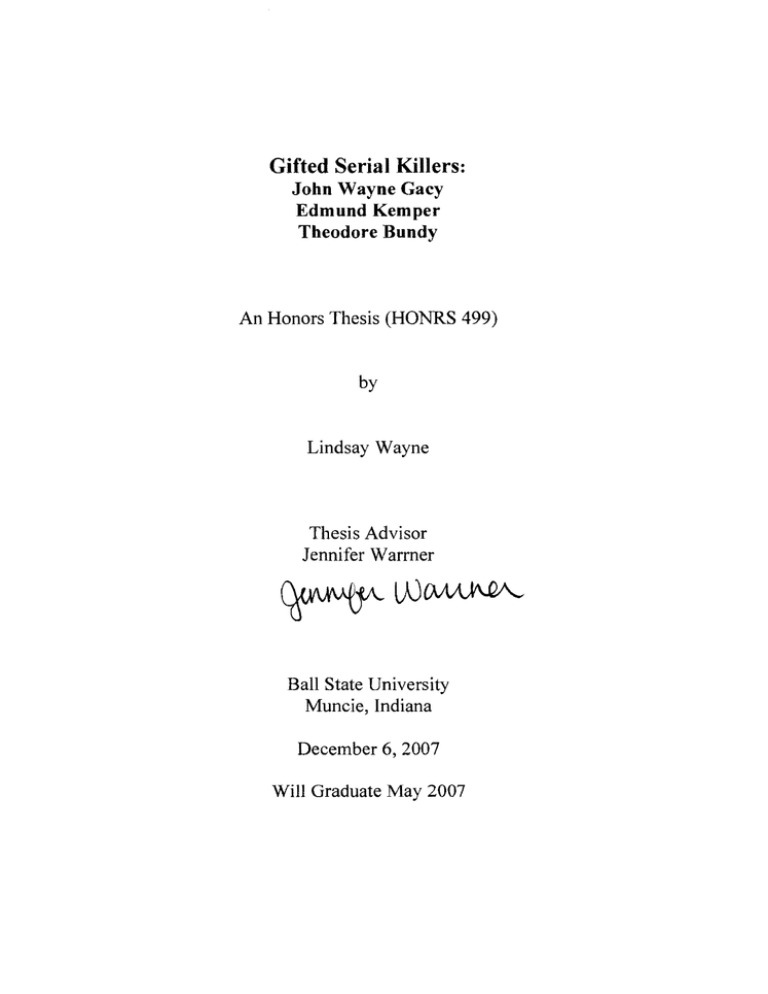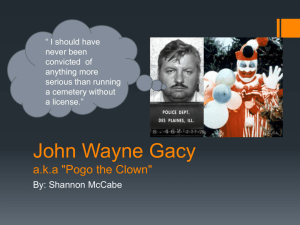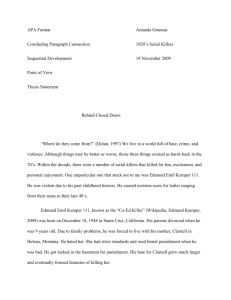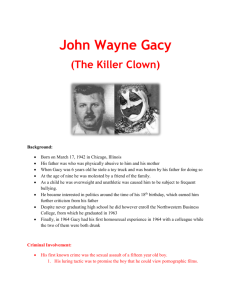Gifted Serial Killers:
advertisement

Gifted Serial Killers: John Wayne Gacy Edmund Kemper Theodore Bundy An Honors Thesis (HONRS 499) by Lindsay Wayne Thesis Advisor Jennifer Warrner Ball State University Muncie, Indiana December 6, 2007 Will Graduate May 2007 r Abstract (~ , ' : t~ l. ' /I,r; '7 The names John Wayne Gacy, Ed Kemper, and Ted Bundy were not made famous by anything good they did. In fact, these three men were some of the most notorious serial killers that the United States has ever seen. Each man was very different in the way he killed, his victim choice, and his general personality. In this paper, I describe the general background and actions of each killer, and then give a profile of each killer. Criminal profiling is a recent trend, but law enforcement now utilizes criminal profilers to examine crimes and crime scenes to help get an idea of the personality of the person responsible. Finally, I explain the gifted characteristics that each killer possessed, as this project was inspired after taking a class on giftedness. Acknowledgements I would like to thank Ms. Jennifer Warmer for helping to both inspire this thesis idea and for supporting me through the completion of this project. Her creativity and advice helped to keep me motivated and focused. ANTED by the FBI JOHNWAYNEGACY "Killer Clown" Date of birth: MARCH 17,1942 Race: WHITE Sex: MALE Eyes: BROWN Hair: GRAY Wanted for: Rape and murder of 33 boys and young men Gifted characteristics: Above average intelligence, Interpersonal intelligence and a strong leader John Wayne Gacy Background John Wayne Gacy was born in Chicago in March of 1942, the second of three children to Marion and John Stanley Gacy. He was raised in a middle class neighborhood, and kept busy with Boy Scouts and different part-time jobs. Gacy had a very stressful relationship with his father, who was a verbally abusive alcoholic, and the two were never close. After spending time in Las Vegas working, Gacy moved back to Chicago in the early 1960's. He enrolled in a business college, and found he was talented as a salesman. Eventually, Gacy rose to a management position for Nunn-Bush Shoe Company in Springfield, Illinois. In Springfield, Gacy was very involved in the community in organizations such as the Chi Rho Club, the Catholic Inter-Club Council, the Chicago Civil Defense, and the Jaycees, where Gacy was even voted "Man of the Year" (Crimelibrary.com, 2006). In 1964, he married Marlynn Myers and moved to Waterloo, Iowa. In 1967, when Gacy was around the age of twenty-six, he began to bring boys to his home. At this point, he was not killing the boys, just engaging them in sexual acts. Gacy claimed the sex was consensual, even though he would do things like tie boy's hands behind their backs before he raped them. Gacy was brought to trial for sodomy and sentenced to ten years in the Iowa State Reformatory for Men in Anamosa. This was the beginning of the end of Gacy's marriage to Marlynn and contact with his children (Morrison, 76). While in prison, Gacy became one of the prison's top chefs and started a prison chapter of the Jaycees. After just seventeen months, Gacy was released for good behavior. After he was released, he moved back to Illinois, and in 1971, he married his second wife, Carol Huff, and they lived in a neighborhood on the northwest 1 side of Chicago. Gacy also started his own business, PDM Contracting. Gacy became a well respected member of the community and was always willing to help his neighbors. He would dress up as a character he called Pogo the Clown to visit sick children in local hospitals, and was well known for throwing back-yard parties with hundreds of guests (Morrison, 86). It was during this time that Gacy began to hunt for his victims. During the night, he would visit an area of Chicago called Bughouse Square, which was then a run-down area where male prostitutes were common (Morrison, 87). This was also around the time when Gacy's second wife, Carol, divorced him. Even while they lived together, he had begun to bury bodies under their home, but she claimed she never noticed anything strange or suspicious. She explained the reason the marriage ended was because he was too busy with his contracting business and helping out neighbors (Morrison, 85). Even though it soon became a common knowledge around Bughouse Square that Gacy was interested in rough sex, many prostitutes in need of money did not take heed. Gacy would drive around Bughouse Square in his Oldsmobile with his own police spotlight and scanner looking for prostitutes. Gacy would bring the boy to his home, and begin to toy with him. Often, he would handcuff the victim, tie a rope around his neck with a board between the knots, and twist the rope with a stick. Then, when the boy was nude and unconscious, Gacy would take pictures until the boy regained consciousness, twist the rope again and repeat this process until the victim died (Morrison, 87). One victim who survived Gacy's torture was Jeff Rignall. In March of 1978, Rignall decided to go to a bar after he argued with his girlfriend. As he walked down the sidewalk, Gacy pulled up in his Oldsmobile and started a conversation. Later Rignall 2 explained that Gacy seemed like a nice guy, and when he offered some marijuana, Rignall got in the car. As Rignall was smoking, Gacy forced a chloroform cloth over his face, and when Rignall awoke, he was in Gacy's house and had been bound and restrained. Gacy forced Rignall to perform oral sex on him, and then Gacy forced different dildos, as well as a fireplace poker, into RignalL When Gacy finished with him, he dumped Jeff Rignall in Lincoln Park (Morrison, 77). Rignall eventually made his way back to his girlfriend's apartment, where she took him to a hospital. The victim who finally brought Gacy to the notice of the police was Robert Piest, who was only fifteen years old when he was killed. He met Gacy at a drugstore where he held a part-time job. Gacy was in the store giving advice to the storeowner about updating the place. Piest overheard Gacy mention the wage he paid his workers, which was much more than he was currently earning. Piest asked a co-worker ifhe could leave early to talk to Gacy about getting a job, and he even told his mom who had come to pick him up that he was going to go speak with Gacy. When Piest approached Gacy, who was in his car, Gacy invited him in the car to talk to him. Gacy explained that he felt Piest was being too aggressive about asking for a job, and says that he told Piest that if he really wanted more money, he should think about selling his body for sex. Gacy then began driving towards his home, and when they arrived, he quickly handcuffed Piest. The next morning, Piest was dead, raped and murdered by Gacy's choking rope. Gacy slept with the body for a while and then dumped the body in the Des Plaines River. A few months later, the remains Piest were found, and Gacy was charged with murder, aggravated kidnapping, deviant sexual assault, and taking indecent liberties with a child (Morrison, 80). 3 Piest's body was one of the few that Gacy disposed of in the Des Plaines River. He actually dragged twenty-nine of his victims into the crawl space under his house and placed them into shallow graves he dug. The bodies were arranged in a circle, and some were so decomposed that cause of death could not be determined. Others had been buried with ropes tied around the neck, and other bodies that had not yet greatly decomposed were found with wads of material in the esophagus, possibly to stop blood from getting onto Gacy's floors (Morrison, 89). The youngest ofGacy's victims was nine, and the oldest around twenty. Cook County Medical Examiner Dr. Robert Stein believed that some of the victims may have been buried alive and had tried to claw themselves out (Wikipedia.org, 2006). On March 12, 1980, Gacy was found guilty of thirty-three murders, and on May 9, 1994, he was executed by lethal injection. Profile While Gacy's thirty-three murders may have seemed to be sexual in nature, they were really about anger and aggression (Morrison, 74). Around the age oftwenty, Gacy had left his family and was working in Las Vegas as an attendant at a mortuary. He admitted to getting into a coffin and holding a dead body to himself while he grew aroused. According to Helen Morrison, M.D., who was certified by the American Board of Psychiatry and Neurology for general psychiatry and was a certified forensic psychiatrist, what Gacy was doing was a combination of experimenting with a body and something he saw as comfortable, and not acting as a necrophile interesting in actually having sexual relations with the bodies (Morrison, 75). F or a person so interested in killing, it seemed strange that Gacy would let a victim live, as Jeff Rignall did. Rignall felt he was still alive because he never resisted, 4 mainly because he was completely restrained. He said Gacy waited until he knew Rignall was experiencing pain, and then put the chloroform cloth back on his face. After he lost consciousness, Gacy would reposition him and when he awoke, explain what he was going to do to Rignall next. Rignall felt that Gacy was turned off by the fact that there was no resistance. Morrison agreed, as she stated, "Rignall may have played a role of submission that allowed him to live. That's not to say that submission would've worked for any victim of a serial crime or any of Gacy's other victims. But at that moment in time, Rignall survived" (Morrison, 79). Morrison also quoted Gacy as saying, " .. .I'm afraid of myself. And afraid I'm going to hell." However, Morrison felt that Gacy had no concept of hell and explained that when he talked about Jesus and Satan, he had no clear distinction of the two in his mind. To him, they were the same being, as he could not differentiate among concepts that were complex, abstract, or philosophical (93). Morrison also describes how Gacy would talk continuously, as ifhe could not stop. The clinical name was logorrhea, a disorder often seen in those in a manic state (95). As he talked, he would explain how he felt he was the victim and was being persecuted by everyone else. Morrison discussed how Gacy liked to portray himself as powerful, influential, smooth, and suave. However, she mentioned that he always seemed a bit in doubt and his emotions were very inconsistent, ranging from where he felt he could rule the world, and then feeling completely down, lonely, and confused with no will to live (97). Morrison felt that even though Gacy had high intelligence, he often worked in a very primitive form of thought. Gacy did not know how to restrain himself verbally, and during most of his life, his impulses were most likely experienced as stimuli coming from outside of himself. He 5 could not think through an issue and come to a logical conclusion, and would act without thinking (Morrison, 98). During the Gacy trial, Dr. Morrison testified on her feelings about Gacy's emotional state of mind and tried to explain how he was possibly capable of committing so many murders. During her testimony, she explained Gacy had primitive psychotic defense mechanisms, where his ego detached from reality. Also, even though he had a very high view of himself, these feelings were combined with those of inferiority. Gacy also used the psychological defense of projection, where any painful feelings inside of him were placed upon another person, and that person became the enemy (Morrison, 107). Overall, Morrison felt that Gacy's emotional functioning was at the level of an infant. He never learned how to control his aggression and was not able to recognize the separateness of people or relate to them (109). Whenever Gacy's feelings overwhelmed him, he became psychologically unstable. His capacity for violent actions took over, and he did not have enough emotional strength to control or keep track of what was happening (Morrison, 110). Gifted Characteristics Giftedness was a concept that is very difficult to define. Most associated giftedness with high intelligence, however, there were many different aspects of giftedness. One gifted characteristic of Gacy was that he possessed above average intelligence. Being intellectually gifted did not necessarily mean that a person will become successful, though in Gacy's case he succeeded professionally in different jobs and when he started his own contracting company. Gacy also seemed to be very interpersonally gifted, one of the multiple intelligences introduced by Dr. Howard Gardner. Gardner felt that multiple forms of intelligence involved two basic standards; 6 one, they were used to find and resolve problems and two, they were considered useful and highly valued by society. This was very true for Gacy. Interpersonal intelligence, as defined by Gardner, was the ability to notice and make distinctions among other people's moods, temperaments, motivations, and intentions (Storfer, 360). Gacy was able to fool many people with his outgoing and helpful personality, and he worked hard to help other people. Interpersonal intelligence was based on being able to interpret and adapt to emotional aspects of situations, and was derived from episodic memory (Storfer, 365). Not only was Gacy able to use his interpersonal intelligence to appeal when he was functioning in normal society, but he also was able to seem normal and nice enough to keep his victims from being put off by his personality. 7 ANTED by the FBI EDMUND KEMPER "The Co-ed Killer" Date of birth: DECEMBER 18, 1948 Race: WHITE Sex: MALE Height: 6' 9" Weight: 280 Eyes: BROWN Hair: LIGHT BROWN Wanted for: Murder and mutilation of eight women Gifted characteristics: Extremely high intelligence Edmund Kemper Background Edmund Emil Kemper III, or Ed, began his killings with his grandparents. When he was fifteen, he lived with his grandparents on their ranch in North Fork, California. He was already a very troubled person and did not get along well with his parents or his sisters. Before he was ten, Kemper committed his first murder, killing a cat. He buried it alive in the yard, and when it was dead, he cut of its head and placed it on a stick, keeping it in his room to pray over it (Cheney, 9). Kemper especially hated his mother, and as his grandmother reminded him of his mother, he hated her as welL "1 couldn't please her. It was like being injaiL I became a walking time bomb and I finally blew," Kemper said (20). On August 27, 1964, while sitting at the table with his grandmother, she criticized him, so he got up and grabbed his rifle to go hunting. When he got to the porch, he felt a rage inside him, and turned, leveled the gun at the back of his grandmother's head, and fired. He fired twice more into her back. His grandfather returned from the store, and when he climbed out ofthe car, Kemper aimed the rifle at his grandfather from inside the house. He shot his grandfather in the back of the head, and then dragged the body into the garage (Cheney, 21). Not knowing what to do next, he called his mother and confessed. Officers quickly showed up at the house, and Kemper was taken in for questioning. After he admitted to killing his grandparents, he was sent to Atascadero State Hospital in California for treatment by the California Youth Authority (Cheney, 22). In Atascadero, he began to talk with other patients, including rapists. Here, Kemper began to have violent sexual fantasies, and resolved to himself that when he was back in normal society, he would be much smarter than the men in jail and leave 8 no witnesses, and not get caught (Cheney, 31). After five years in Atascadero, Kemper was released to a halfway house run by the California Youth Authority, with the hospital staff recommendation of never being able to live with his mother again (Cheney, 33). While Kemper was in the hospital, his mother moved to Santa Cruz, California, and obtained a job as a secretary at the University of California Santa Cruz. After just three months at the halfway house, Kemper was paroled to his mother (Cheney, 35). In 1969, he bought his first car as well as knives and guns, and began to drive around picking up the prettiest and smallest female hitchhikers to talk. He used this period to learn and to observe the actions of the women to see what he could do to make them feel more comfortable (Cheney, 41). Kemper's first two victims were female college students, Mary Ann Pesce and Anita Luchessa, who were hitchhiking to Stanford University. Once in his car, he told the girls he was going to rape them, and Mary Ann tried to talk him out of it. Kemper had already decided he was going to kill both of them, and though he says he would have enjoyed raping them, he was concerned about his lack of sexual experience. Cheney quoted Kemper as explaining, "I'd had very limited exposure to the opposite sex and I guess the learning point fifteen to twenty-one - I was locked up with all men, and there wasn't any opportunity to be with women or girls," and he seemed to be more comfortable with killing than with sex (88). He forced Anita into the trunk of his car and cuffed Mary Ann, placing a plastic bag over her head. Mary Ann kept fighting back, and Kemper grew anxious and frustrated with her, so he took his knife and began to stab her in her back. She was in great pain, and while moving around to try to get away from the knife, Kemper stabbed her in her stomach. She turned back over onto her stomach, and he continued to stab her in her back. Kemper felt like he was getting 9 nowhere, and Mary Ann kept fighting back and calling for Anita, so he finally grabbed her chin and cut her throat. He then moved to Anita, and told her that his hands were bloody because he though he had broken Mary Ann's nose, so she should climb out of the trunk and help her. Kemper tried to stab her, but her clothes were too thick for the knife to penetrate. She also began to fight back, but he was still able to stab her throat, her heart, and her arms to the point where her bones were visible. Kemper explained how he could tell when she started dying, because she slowed down and became delirious. He then put both girls in his car and drove to his apartment. He took both girl's bodies inside, and dissected Mary Ann and decapitated Anita. Kemper ended up killing four other young females he picked up while they were hitchhiking. Though he did not sexually abuse the first few victims, his fourth, Cindy Schall, whom he shot in the head, he took to his horne and when his mother had left for work, performed sexual acts with her dead body. After he finished, he dissected the body and threw the parts over a cliff (Cheney, 113). He engaged in sex acts with his next two young victims, both after they had been decapitated. After the six murders of young female hitchhikers, Kemper decided it was time to kill his mother. "I certainly wanted for my mother a nice, quiet, easy death like I guess everyone wants," Kemper explained (132). He took a hammer and a knife with him into her bedroom, and then began to hit her head. When blood began to flow, he moved her onto her back, cut her throat, and then decided to cut her head entirely off (Cheney, 133). When his mother's friend, Sally Hallett, stopped by, he decided to kill her, too. When she carne inside the house, he began to hit her, and eventually choked her to death using his arm (Cheney, 137). Once her body was in rigor mortis, he beheaded her, and hid her body in a closet (Cheney, 139). After Kemper killed 10 his mother's friend, he called police to turn himself in, and even showed police where he had buried victim's bodies and heads. Kemper was found guilty of eight murders, and sentenced to life in prison (Cheney, 193). Profile Ed Kemper was obviously a person with many problems, but what was so interesting and frightening about him is that he was so aware of his actions. Professionals talked with him to try to understand his motivations, yet Kemper himself seemed eager to provide great insight into his thoughts and actions. Other killers were often ready to grab onto any excuse for their actions, but Kemper was quite aware that he performed some very sick acts. Talking with police after he had admitted to his eight murders, Cheney quotes Kemper as explaining, "The whole series of things was very sick, I realize that better than anybody. The thing that hits me is that when I'm lucid and thinking normally and rationally, it's very painful. But I had set up certain rules. What these were, were fantasies come to life. I decided I was tired of hiding in my little fantasy world ... so I decided on this rebellion ... like conquests or something like this, my fantasies were usually around women" (95). Even though Kemper had a rough childhood and grew up with an abusive mother with whom he did not get along, his crimes cannot be blamed on his childhood. As retired FBI criminal profiler, John Douglas, explains neglect and abuse of young children did have strong potential to create psychologically messed up people, but there was no automatic link to those people being compelled to commit violent crime (37). Douglas believed that Kemper's actions were probably a very disturbing way to get back at his 11 mother. By turning himself in, Kemper made the choice to stop killing, as he was the one who had chosen to start in the first place (Douglas and Olshaker, 39). Kemper was definitely very intelligent, and was very aware of the crimes he committed. Talking to Douglas, Kemper explained that he felt his mother hated him because he looked like his father and would take her frustrations out on him. Through her punishment, he developed a hatred for women. Kemper discussed how he was able to figure out how to put girls at ease to make them feel they were safe before killing them, and how it felt like a game to him. Douglas explained that Kemper's goals were to manipulate, dominate and control his victims. Kemper definitely seemed to conform to this description, as he explained he that wanted his victims to belong to him completely, and for him, this meant a loss oflife (Crimelibrary.com, 2006). He felt that when the victims were alive, they were distant and not interested in forming a relationship with him. When they were dead, he knew that they were now his (Cheney, 108). Though many cannot understand the actions of killers like Kemper, Cheney states, " ... such criminals were brutalized as young children and have spent their entire lives in a depressed environment. They are a very normal product of a slum. In assessing where they stand in relation to their world, they are eminently sane" (Cheney, 220). When Kemper killed his grandfather, he rationalized to himself that it was a mercy killing, preventing his grandfather from suffering the loss of his wife. This was obviously very illogical, but Kemper felt that death spared the living from pain (Cheney, 22). When Kemper killed his mother, he felt that killing her would save her from the shame of knowing that her son was the mass murderer the police were looking for (Cheney, 69). Much like John Wayne Gacy, Kemper never developed a positive sense of 12 personality and often experienced uncontrollable rages. However, he seems very logical in his explanation of his actions. Kemper stated" ... I really killed my grandmother because I wanted to kill my mother ... I had this love-hate complex with my mother that was very hard for me to handle ... " (Cheney, 29). While Kemper was living in Santa Cruz with his mother, and he began to try to talk to girls, he preferred those who were petite, pretty, and well put together. He also developed a strange mix of fascination and hatred for the upper-middle class female who thought she was better than him. His fantasies also began to grow more violent, "I had fantasies about mass murder, whole groups of select women I could get together in one place, get them dead and then make mad passionate love to their dead corpses' ", Kemper explained (42). After Kemper began to kill his victims, he always returned to the site. Reasons for this included trying to recapture the excitement and horror of his actions, and maybe even subconsciously, the wish to be caught and punished. He also returned because of his concern for the success of his plans and his desire for perfection (Cheney, 94). Kemper also decapitated his victims, as the act of beheading filled a subconscious need (Cheney, 97). Decapitation also gave Kemper a sexual thrill, and he compared the feeling to that of triumph, like how a hunter would feel when taking the head of a deer (Cheney, 108). Gifted Characteristics Often, when most think of being gifted, they think of giftedness relating to intelligence. Jean Piaget, in his book, The Psychology of Intelligence, described intelligence as a generic term used to indicate the superior forms of organization or l3 equilibrium of cognitive formation (7). In Kemper's case, high intelligence was his strongest gifted characteristic. Kemper was extremely intelligent and very self aware. Being able to successfully analyze his own self was also a trait of intrapersonal intelligence, one of the multiple intelligences set forth by Howard Gardner. Intrapersonal intelligence was the ability to examine and comprehend one's own feelings (Storfer, 360). Former FBI criminal profiler John Douglas described Kemper as having "superior intellect, insight, and willingness to confront the monsters within him" (Douglas, 39). Kemper was satisfied with his IQ of 136, which labeled him as having superior intelligence, but he really took pride in how well he could observe and remember details (Cheney, 3). Kemper was always very perceptive of his surroundings, and would analyze his interactions with girls to find ways to make them more comfortable. Many cognitive psychologists considered the ability to generate insight a major aspect of intellectual giftedness (Storfer, 372). Also, Robert Sternberg's Triarchic Theory ofIntelligence, which stated that intelligent people have the ability to find success within their sociocultural context, was true for Kemper. Success was achieved once strengths were identified and weaknesses were corrected to adapt to environments. The ability to adapt to their environment involved analytical, creative, and practical skills (Yale.eduJrjsternberg, 2006). Kemper continuously adapted to his surroundings to accomplish his murders. He was able to eliminate some of his own shortcomings to create a false sense of security and comfort for the girls he picked up. He also learned from each girl he murdered, and took precaution to keep from being caught. 14 ANTED by the FBI THEODORE "TED" BUNDY Date of birth: NOVEMBER 24, 1946 Race: WHITE Sex: MALE Height: 5' 11" Weight: 155 Eyes: BROWN Hair: BROWN Wanted for: Brutal rape and murder of at least 23 women Gifted characteristics: Very intelligent with interpersonal intelligence Theodore Bundy Background Growing up as a shy and awkward teenager, Theodore "Ted" Bundy was always a good student. Born November 24, 1946 to Louise Cowell in Vermont, Bundy and his mother lived with her parents for the first nine years of his life (Wikipedia.org, 2006). He and his mother eventually moved to Tacoma, Washington, and Bundy went to college at the University of Washington (UW), where he studied psychology. He also met and entered a relationship with a young, wealthy, dark-haired woman during this time. Their relationship lasted for many years, though Bundy often felt inferior to her (Larsen, 94). Bundy worked hard to impress her and was able to earn a summer scholarship to Stanford. However, this woman soon realized Bundy had some issues and ended the relationship with him, which lead him to become depressed and drop out of school. After she returned to California they kept in touch, and while he was on a trip in California, they met up again. She was impressed with his maturity, and she fell in love with him. However, after months of dating, Ted suddenly ended things, rejecting her as she had rejected him. Some theorize that this first girlfriend of Bundy's led him to prefer slender, dark-haired young women (Crimelibrary.com, 2006). Bundy's first confirmed murder was in 1972, when he was twenty-seven years old, though many police and other officials believe he began killing before this. A psychology major at UW, twenty-one year old Lynda Healy was a pretty, thin, brownhaired girl. When she did not show up to work one day in late January, those close to her became concerned. After checking her room to see if she was still sleeping, blood was found on her pillow and sheets, and a bloodstained nightgown was hanging in her closet 15 (Larsen, 14). Skeletal remains of her skull were later found on Taylor Mountain in March of 1975, the third of four skulls and jawbones found on the mountain (Larson, 62). Only a few weeks prior to Lynda's disappearance, eighteen year-old Susan Clarke was found lying in her blood after being assaulted, sexually tortured, and beaten. She was in a coma for months, but did survive. In just three months, at least four other girls were reported missing. All of the victims were attractive white college-aged females with long straight hair parted in the middle. During July, Janice Ott and Denise Naslund both disappeared from Lake Sammamish, a state park in Washington. This was when police first obtained a description of Bundy. Another young woman at the park remembered a young man with a cast on his arm who introduced himself as Ted. He asked for help loading a sailboat onto his car, but when they got to his car there was no sailboat. He explained it was at his parent's house just up the road, and they had to drive to get it. At this point, she grew suspicious and said she had to get back to her family. This woman said she later saw Bundy in the crowd, heading toward the parking lot with a woman (Douglas and Olshaker, 301). When Bundy got a woman to his car, he often used his fake cast as a weapon, and hit the girl in the head, making it easier to force her into his car (Douglas, 302). Once, Bundy posed as a police officer inside a Sears to Carol DaRonch, who was seventeen. He explained there was an attempted burglary on her car, and he needed her to identify a suspect who was supposedly outside with his partner. Bundy purposely led her to a locked building where he said his partner was, and when nobody was there, he explained he must have already gone to headquarters, and explained that Carol needed to go there as well. They got in his car, but she soon noticed its worn and ratty appearance, and after 16 driving for a few minutes, Bundy slammed on the brakes, and tried to handcuff Carol. She struggled against him, and managed to open the door just as Bundy was reaching to hit her with a metal bar. She managed to get away from Bundy, and ran out onto the street, and a couple in an approaching car stopped to help her (Larsen, 44). However, it seemed Bundy did not have problems finding other victims, and young women continued to go missing. The bodies would sometimes be found before becoming decomposed, and would always be nude, with some sort of injury to the skull (Douglas and Olshaker, 303). At this point, Bundy began to have some problems. He was arrested in Salt Lake City, once on suspicion of burglary, and again for reckless driving, where police found handcuffs, panty hose that had been used as a stocking mask, and receipts showing some ofthe city's in Colorado he had visited. Police were able to eventually tie him to Carol DaRonch, and she was brought in to identify him, leading to a conviction of kidnapping. He was then extradited to Colorado for the murder of a young woman named Caryn Campbell. He escaped from the jail, and after traveling through many states ended up in Florida (Douglas and Olshaker, 303). By now, it was 1978, and Bundy had found a place near Florida State University. Late in the night on January 15, he went to the Chi Omega sorority house, and two girls were left dead, one severely beaten. Lisa Levy was rushed to the hospital in an attempt to save her. However, due to injuries ranging from severe head injury, rectal bleeding, bite marks on one nipple and buttocks, swelling on her neck, and bleeding from her eardrum, she was pronounced dead. The other, Margaret Bowman, was found with a hole in her skull, and a rope pulled tight around her neck, and was pronounced dead at the scene. Karen Chandler was the third victim and lived, but was still injured with a broken jaw 17 (Larsen, 215). After only a few minutes, Bundy left the Chi Omega house and headed just six blocks to a small duplex. Debbie Cicarelli, who lived on one side of the duplex, woke up after hearing strange noises from the other side of the building, where her friend, Cheryl Thomas lived. Debbie called the police, who made their way inside the duplex, finding Cheryl bloody and semiconscious (Larsen, 217). Cheryl had her scull fractured in five places, but still survived, though she was left with deafness in one ear and problems with balance. Bundy fled to Jacksonville, Florida, where he claimed his final victim, twelve-year-old Kimberly Leach, whose body was eventually found with her neck sliced in an abandoned hog shed (Douglas and Olshaker, 305). Bundy continued to flee from police until late February when a police officer pulled him over. During the trial for the Chi Omega murders, Bundy was sentenced to death by electrocution. The next year, he was convicted for Kimberly Leach's murder, again sentenced to death (Douglas and Olshaker, 307). After ten years on death row, on January 24, 1989, Bundy was executed by electrocution. Profile Many people were fascinated by Ted Bundy because he seemed so unlikely to be capable of such horrible crimes. However, Bundy's criminal activities began when he was a teenager. Even though his crimes then seemed marginal to his later murders, John Douglas, in his book, Obsession, warned about the potential progress into more serious crimes. It has been noted, especially in rape cases, that the perpetrators begin with window peeping and other voyeurism, which is true of Bundy (90). Douglas also discussed that even though Bundy was not physically abused as a child, his childhood was still stressful from having to move around and never knowing his father. Bundy also 18 soon realized he had a taste for a lifestyle which his family could not afford, and combined with his personality and his inability to empathize with other people, without any intervention, he had great potential to become someone very dangerous, as he did (Douglas and Olshaker, 300). Even though Bundy was well educated, attractive, and many doubted his role in the murders of so many women, he was, as Douglas stated, "Nonetheless irredeemably flawed in terms of character and conscience .. .if you intentionally assault or kill women for the sheer please and satisfaction of it, you are a monster who has to be removed from society" (130). Bundy himself seemed well aware of his lack of character, once describing himself to police officers as " ... the most cold-blooded son a bitch you'll ever meet" (Douglas and Olshaker, 306). While Bundy was in the Colorado jail, he supposedly asked a jailer which states were most likely to execute a convicted murderer, to which the jailer replied either Texas or Florida. When Bundy escaped this jail, and made his way to Florida, some interpreted this as a desire to be caught. Douglas disagreed and explained that most murderers do not wish to be caught, and those that do make it easy, as in the case of Edmund Kemper, who called police to tum himself in (303). According to Douglas, Bundy's move to Florida served to boost his confidence and arrogance, and not only manipulate, control, and dominate his victims, but the entire law enforcement community. By choosing to go to Florida and still being able to murder and get away with it, Bundy was just strengthening his existing belief that he was above the law (Douglas and Olshaker, 304). Douglas also felt that Bundy followed the classic behavior of a depraved sexual sadist, who enjoyed hunting the victim more than the actual murder. Bundy even 19 admitted that after kidnapping Janice Ott and Denise Naslund, he kept them alive as long as possible and made one watch while he killed the other (Douglas and Olshaker, 307). Gifted characteristics Ted Bundy was a very intelligent person. Though he did not possess the remarkable intelligence of Ed Kemper, Bundy was still quite smart. He never was outstanding in school, but he got decent grades and was able to go to college. He eventually graduated from law school at the University of Utah and was very interested in a career involving politics. Bundy even felt he was capable enough to act as his own defense attorney during the Chi Omega trials. He enjoyed being able to argue on behalf of himself, and even questioned some of the witnesses in the trial (Larsen, 267). However, Bundy was still found guilty in this trial, and at the trial for Kimberly Leach, his final victim, he did not represent himself again. Bundy was also gifted with interpersonal intelligence, and just as those close to John Wayne Gacy were shocked to hear about his murders, friends of Bundy could not comprehend that he was capable of so many horrible killings. Combined with his attractive features, Bundy was able to make many different friends and seemed to get along well with others. Bundy was very perceptive of other's emotions and feelings, and would manipulate those around him with his charm and charisma. Where Gacy relied on interpersonal intelligence to relate to those around him, Kemper was very awkward with obvious emotional issues, and was most gifted with strong intelligence. Bundy was an interesting mixture, a likeable person who was definitely more intelligent than the average person. 20 Works Cited Cheney, Margaret. The Co-ed Killer. New York: Walker Company, 1976. Douglas, John and Mark Olshaker. Obsession. New York: Scribner, 1998. Edmund Kemper: The Co-ed Butcher, Ramsland, Katherine. 2005. Crime Library. 28 November 2006 <http://www.crimelibrary.comlserial_killers/predators/kemper/edmund_l.html>. Ed Kemper. Wikipedia. 01 December 2006 <http://en.wikipedia.org/wikilEd_Kemper>. John Wayne Gacy. 2005. Bardsley, Marilyn and Rachael BelL Crime Library. 30 November 2006 <http://www.crimelibrary.comlserial_killers/notorious/gacy /gacy_I.html>. John Wayne Gacy. Wikipedia. 29 November 2006 <http://en.wikipedia.org/wiki/John_Wayne_Gacy>. Larsen, Richard W. Bundy: The Deliberate Stranger. New Jersey: Prentice-Hall, 1980. Morrison, Helen. My Life Among the Serial Killers. New York: HarperCollins,2004. Piaget, Jean. The Psychology of Intelligence. New York: Harcourt, Brace & Company, 1947. Robert J Sternberg. Robert, Sternberg J. Yale University. 03 December 2006 <http://www.yale.edulrjsternberg/>. Stoddard, George D. The Meaning of Intelligence. New York: Macmillan, 1943. Storfer, Miles D. Intelligence and Giftedness. San Francisco: Jossey-Bass, 1990. Ted Bundy. 2005. Bell, Rachael. Crime Library. 01 December 2006 <http://www.crimelibrary.com/serial_killers/notorious/bundy/index_I.html>. Ted Bundy. Wikipedia. 01 December 2006 <http://en.wikipedia.org/wiki/Ted_Bundy>. 21 Gifted Serial Killers Lindsay Wayne December 6, 2006 Serial Killers • Usually involve three or more victims • Killer is not a risk taker • Victims are usually strangers • Victims share similarities like gender or age 1 John Wayne Gacy • Born in Chicago in 1942 • Once voted "Man of the Year" • Began to rape victims in 1967. in Iowa • Sentenced for sodomy, released after 17 months • Moved back to Chicago in 1971 John Wayne Gacy • Started own contracting company • Bughouse Square • Killing rope • Jeff Rignall and Robert Piest 2 Ed Kemper • Killed his grandparents at 15 • Spent five years in a state hospital • Paroled to mother in Santa Cruz, CA • Purchased first car in 1969 and began to pick up hitchhikers Ed Kemper • Mary Ann Pesce and Anita Luchessa • Decapitated and had sexual relations with victim's bodies • Killed mother as she slept 3 Ted Bundy • Born in 1946 • First relationship with slender dark-haired college woman • First known murder at age 27, killed Lynda Healy • Would approach potential victims asking for help Ted Bundy • Chi Omega murders • 2 killed, 1 injured • Cheryl Thomas • Kimberly Leach 4 Victims • • • • • • • • • • • • • • • • • • • • • Jan, 4, 1974: Karen Sparks (survived), Battered in her bed as she slept. Remained comatose for several months, but eventually awoke Feb, 1, 1974: Lynda Healy (21), Battered unconscious while asleep and abducted from the house she shared with other University of Washinglon co..ads, Mal. 12, 1974. I)o'Jlia MaliSOn (19).AOdocted ariel waltJ\illQ to aialZ WI tcel t 011 t!v9Igle&lt calilpus, yvaSllillgtolt Apr, 17, 1974: Susan Rancourt (18), Disappeared as she walked across Central Washington State College lawns, May. 6,1974: Roberta Kathleen Parks (22). Vanishes while walking to another dOrm hall to have coffee with friends, June. 1, 1974: Brenda Ball (22), Disappears from the Flame Tavem in Burien, Washington. June. 11, 1974: Georgeann Hawkins (18). Disappears from behind her sorority house, Kappa Alphe Theta in Seattle, Washington July, 14, 1974: Janice Ott (23) and Cenise Naslund (19), both from Lake Sammamish Slate Park. Aug, 2, 1974: Carol Valenzuela (20), Last seen at a we~are office in Vancouver, Oct 2, 1974: Nancy Wilcox (16). Disappeared in Holladay, Utah Oct 18, 1974: Melissa Smith (17). Vanished from Midvale, Utah on her way to a friends house Oct 30, 1974: Laura Alme (17), Disappeared from a Halloween party at lehi, Utah, Nov, 8, 1974: Carol OaRonch (19, survived), Escaped Bundy by jumping from his moving car, Nov, 8, 1974: Cebbie Kent (17). Vanished hours after DaRonch escapad from Bundy, Jan. 12, 1975: CalYn Campbell (23). Abducted while on a ski trip in Aspen, Coloredo. Mar. 15, 1975: Julie Cunningham (26), Disappeared while on her way to a nearby tavem in Vail, Colorado Apr. 4,1975: Denise Oliverson (25). Abducted while visiting her parents in Grand Junction, ~:~o6, 1975: Lynette Culver(13), Snatched from a school playground at Alameda Junior High School, Pocatello, June. 27, 1975: Susan Curtis (15). Abducted from the campus of Brigham Young University. Jan. 15, 1978: Lisa Levy (20), Margaret Bowman (21), Karen Chandler (survived), The Chi Omega killings, Tallahasse, Florida Jan, 15, 1978: ChelYl Thomas (survived), Bludgeoned in her bed, eight blocks away from the Chi Omega house Feb. 9, 1978: Klmbeny Leach (12), kidnapped from her junior high school, Lake City, Florida, Gifted Characteristics • High intelligence • Interpersonal giftedness • Howard Gardner 5 Guilty • John Wayne Gacy was found guilty of 33 murders, and executed May 9, 1994 • Kemper called police and turned himself in. He was found guilty of 8 murders and is serving a life sentence. • After 10 years on death row, Bundy executed by electrocution on January 24, 1989 6







